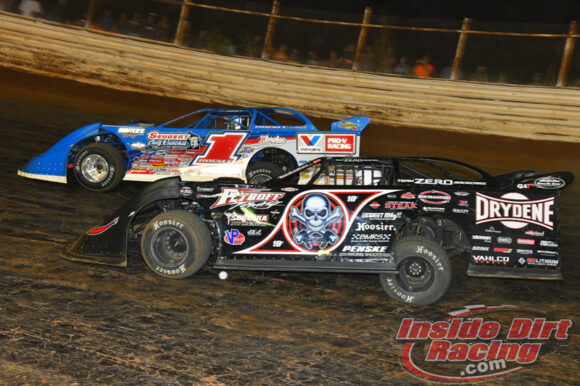As you know, 2020 has been a year of change in all aspects of life because of the coronavirus pandemic. No matter what your beliefs, political or otherwise, you cannot deny that life today is not the same now as it was one year ago. And the sport of dirt racing has seen as much change over the past twelve months as any other facet of our lives.
During the past year, we lived through a time in which racing, along with almost everything else, was shut down for a period of time, the length of which depending on the place you call home. And as a result, the way we watch, keep up with, and participate in this sport that takes place on clay surfaces all over the country was changed.
So how many of those changes that have happened over the past twelve months are here to stay, even when the sickness has become less of an issue?
One thing that had already been in place, but was greatly expanded during the pandemic, was the use of pay-per-view broadcasts to make dirt racing available to more fans. As a matter of fact, it was these live airings that initially brought the sport back from its time of hibernation.
DirtonDirt.com/FloRacing.com, DirtVision.com, Speed51.com, and Lucas Oil Racing TV were among the several providers that aired live programming of Dirt Late Model and Sprint Car racing throughout 2020. Some of those races were shown from venues that had no fans at all while others were made available from facilities with limited numbers of fans.
Again, this was something that certainly was not new to dirt racing, but at the same time, there was absolutely a proliferation of the showing of live dirt races during this highly unusual season. People who may have lived hundreds of miles away from a particular track were able to watch live a show from that facility on a laptop or a tablet by simply logging into a website. Often times, these were fans who would have never seen a race from that particular venue otherwise.
There is no reason to believe that practice of showing live races is going to change as long as the streaming services are making money and the tracks/series are willing to allow it to happen. Almost certainly, the broadcasting of major races will continue to grow as time goes on, pandemic or not. This has likely become a habit some will find hard to break in the future.
It would seem logical to say that the numbers of subscribers to these various services have probably increased during this pandemic. As a result, one has to wonder what impact these subscriptions will have on the individual tracks going forward. In other words, how willing might a person who is paying one or more subscriptions be to then go to a track and pay a grandstand admission while letting the already paid for online offering go unwatched?
Once the now increased number of viewers to online events have come to realize that watching races from their favorite chairs inside their homes is much more comfortable and easier than travelling to a track located miles away, sitting in cold or hot temperatures on a metal or concrete grandstand, standing in line at a concession stand, using a restroom that may not be the cleanest, and then driving back home at a very late hour, they may choose to watch from home more often.
An example from my own life will fit here. When I was younger, I used to think there was nothing like going to college football and basketball games at the University of Tennessee. I went as often as I could, even holding season tickets for a time. Then, with the proliferation of TV networks showing pretty every game the Vols played, I came to realize that I could watch from home and not have to use up an entire afternoon or evening in the process.
And to tell the truth, that same mindset crept in to my way of thinking about racing a few times this past year. I love going to race tracks, watching the events in person, and talking to some great people. However, there were times when hours of driving and the realization that some tracks allow their racing programs to drag on far longer than is necessary, staying home and watching online seemed like a better option.
I have a feeling I am not the only person who came to that realization in 2020.
One concern of such a practice is the impact it might have on weekly racing shows. If more fans make the decision to stay home and watch the Lucas Oil Late Model Dirt Series or the World of Outlaws Morton Buildings Late Model Series on a screen, local tracks could suffer. And indeed, we are seeing some tracks here in east Tennessee and all over the country that have long been havens for weekly racers switch to a special events only types of schedules.
Some might consider staying home and watching stars such as Jimmy Owens, Scott Bloomquist, Brandon Sheppard, and Tim McCreadie virtually every time they compete to be preferable over going to their local track.

Might fans choose more often to stay home and watch stars such as Scott Bloomquist(0) and Brandon Sheppard(1) race in a PPV event rather than go to a track?
Along that same line, some tracks have had to learn to run a more efficient shows because of the influence of television and pay-per-view broadcasts. The streaming services obviously depend on subscribers and they want to be able to offer those patrons a program that will get to the feature race in a timely manner rather than drag on well past the viewer’s bedtime. Part of that streamlining has been done by reducing the number of classes being run.
Some of the online events shown this year featured only one class. That would be highly unlikely to take place at a track where fans are being allowed in. However, the streaming services may start asking for fewer classes in order to cut down on the overall time of the broadcast. That could result in some divisions either going away or being left out of particular programs.
Obviously, for that type of thing to happen, track owners are going to have to be getting a cut of the revenue from the online providers to make up for losses at the gate. No promoter is going to hurt his own bottom line to accommodate a broadcaster who is not willing to share the profits.
And finally, a change that occurred over the past year that became quite obvious was the need for flexibility in scheduling. 2020 showed us that racing schedules do not have to be etched in stone. We already knew that weather is a factor that would cause disruptions but now we have seen that other factors such as government regulations can also disrupt plans.
There were even some instances this past year in which one series would be booted off of a track’s agenda to make way for a bigger tour. Just because an event is on the schedule for a certain day does not mean it is guaranteed to run on that day. And again, broadcasters may play a role in determining when it would be best to change a schedule for weather-related issues or otherwise. Mid-week races and back-to-back shows could become more prevalent even if it means fewer fans in the stands as long as it brings in more pay-per-view subscribers.
So yes, 2020 was most definitely a year of change. And some of those changes might very well signal a much bigger time of transition for this sport.
Respond to this post on Twitter by following @RichardAllenIDR and @MichaelRMoats or by liking the InsideDirtRacing.com Facebook page.
Also, NASCAR and pavement racing fans can check out InsideCircleTrack.






